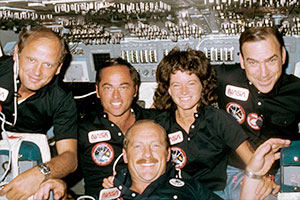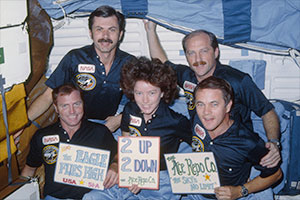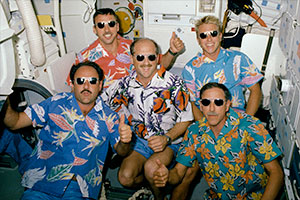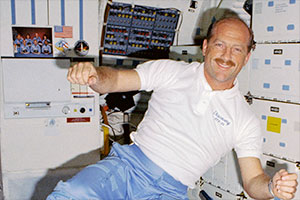 advertisements advertisements
|

|
Astronaut Rick Hauck, who led first flight after Challenger, dies at 84
November 7, 2025 — Former NASA astronaut Rick Hauck, who flew on three history-making space shuttle missions, including the "return to flight" following the Challenger tragedy in 1986, has died at the age of 84.
Hauck's death on Thursday (Nov. 6) was noted by the retirement home where he lived in Maine and by notices from the American Space Museum and Astronaut Scholarship Foundation in Florida.
"Captain Rick Hauck, a man whose courage carried him through every chapter of life, from commanding missions in space to bravely facing Parkinson's disease for more than 15 years," wrote the staff at The Heron House. "Rick was a NASA astronaut, naval officer, physicist, husband and father, but to those of us who had the honor of knowing him here, he was something even more profound: a man of quiet strength and dignity."
Hauck's spaceflight career included a number of highlights but perhaps most prominent was his command of STS-26, NASA's first space shuttle launch after the loss of Challenger and its crew.
'Resumed the journey'
At the time of the tragedy, Hauck was training for his third spaceflight, a mission that had its own set of safety concerns as a result of including the first liquid-fuel upper stage rocket designed to be launched in the shuttle's payload bay. In the wake of the disaster, he supported the recovery by reviewing requirements at the Johnson Space Center in Houston, when Hauck's next flight changed: instead of deploying a probe to study the sun, he would lead Discovery's crew on a mission to restore confidence in the U.S. human spaceflight program so it would continue.
"As an astronaut, there's nothing I'd rather do than command this next flight," he told Jim Fletcher, NASA Administrator at the time, as Hauck recalled for a NASA oral history interview in 2003 and 2004.
Together with his crewmates Richard "Dick" Covey, Mike Lounge, David Hilmers and George "Pinky" Nelson, Hauck lifted off with redesigned solid rocket boosters and ofter safety-driven improvements on Sept. 29, 1988. During the four-day STS-26 mission, the astronauts deployed a Tracking and Data Relay Satellite (TDRS-C) and paid tribute to Challenger's fallen crew.
"Today, up here where the blue sky turns to black, we can say at long last, to Dick [Scobee], Mike [Smith], Judy [Resnik], to Ron [McNair] and El[lison Onlzuka], and to Christa [McAuliffe] and to Greg [Jarvis], dear friends, we have resumed the journey that we promised to continue for you. Dear friends, your loss has meant that we could confidently begin anew. Dear friends, your spirit and your dream are still alive in our hearts," Hauck said, concluding his crew's remarks.
As serious an endeavor as it was, Hauck also felt it important "to have those times when you can relax."
"Human beings need a certain amount of smiling and laughing," he said.
"Once we had the weighty issues behind us ... we decided now is the time to break out the Hawaiian shirts," Hauck told NASA's historian, referencing a colorful moment during the flight. "Then when we came on over Hawaii, we said, 'Well, here we are, we've got our Hawaiian shirts on and we're just enjoying our day in the sun.' I think I then said, 'Life's a beach,' right? "Life is a beach."
With Hauck at its controls, Discovery landed at Edwards Air Force Base in California on Oct. 3, 1988, clearing the way for the shuttle fleet to resume service.
Ride into orbit
Hauck was chosen to become a NASA astronaut in 1978 with the first 35 candidates selected for the space shuttle program. His first mission assignment was as pilot of STS-7, the second flight of Challenger and the first to include an American woman on its crew.
"Sally [Ride] was great," said Hauck in his 2003 oral history. "She's a number one professional; very industrious; always thinking about the objectives for the flight; and [had] a good sense of humor; very productive. It was a pleasure."
In addition to Ride, Hauck flew on STS-7 with Bob Crippen, John Fabian and Norm Thagard —the largest crew to fly aboard a single spacecraft up to that time. Challenger launched on the six-day mission on June 18, 1983, carrying two communications satellites and an experiment platform to be deployed into Earth orbit (and retrieved in the case of the latter) and, had it not been for poor weather diverting them to California, would have been the first to land back at the Kennedy Space Center in Florida.
For Hauck, the highlight of his first flight came at its start.
"Looking out the window during launch and seeing the sky turn from blue to black in a fraction of a second," he said, describing his most memorable moment before noting that Crippen caught him looking out the window and reminded him to keep his "eyes on the cockpit."
"I guess that's one thing that stands out in my memory. Everything about it was thrilling." said Hauck.
Between his first and last flights, Hauck commanded STS-51A. Discovery, launching on its second mission on Nov. 8, 1984, carried two satellites into space and returned to Earth with another two that, due to technical issues, had been placed into the wrong orbit on an earlier shuttle flight.
For nearly eight days, Hauck, David Walker, Joe Allen, Anna Lee Fisher and Dale Gardner carried out the mission's goals, including conducting two spacewalks that featured the last use the Manned Maneuvering Unit (MMU) tetherless jetpacks.
"So, people say what was your favorite mission, and each one has its own aspects, but this one was innovative, it was challenging, it was unique," said Hauck. "it was the first space salvage in history, where you actually brought something back that was derelict. Everyone worked really hard on it. They had creative people doing creative things."
In total, Hauck logged 18 days, 3 hours and 8 minutes on his three spaceflights, completing 288 orbits around Earth. He was the 119th person to circle our planet and the 126th to enter space according to the Association of Space Explorers' Registry of Space Travelers.
Flight deck to board room
Frederick Hamilton Hauck was born on April 11, 1941 in Long Beach, California.
He received a bachelor's degree in physics from Tufts University in 1962 and a master's of science in nuclear engineering from MIT (Massachusetts Institute of Technology) in 1966. He earned his wings in 1968 and graduated from the U.S. Naval Test Pilot School in 1971.
Hauck flew 114 combat and combat support missions in Southeast Asia off the carrier USS Coral Sea and later was the Navy's lead test pilot for the carrier suitability of the F-14 Tomcat. He was also the operations officer of a carrier wing flying the A-6, A-7 and F-14 from the deck of the USS Enterprise.
After his selection by NASA and before his first launch, Hauck devised the layout for the emergency procedures checklist used on the space shuttle. He was then assigned to the support crews for STS-1 and STS-2, serving in Mission Control as a reentry capcom for both.
Between concluding his work recovering from the Challenger tragedy and training for STS-26, Hauck reported to NASA Headquarters in Washington, D.C., where he was appointed associate administrator for external relations, advising the NASA Administrator (Fletcher) on congressional, public, international, intergovernmental and educational affairs.
In March 1989, Hauck resigned from NASA and the astronaut office and two months later became director of the Navy space systems division in the Office of the Chief of Naval Operations, giving him budgeting responsibility for the Navy's space programs.
Hauck concluded his military active duty on June 1,1990 with the rank of captain.
In October 1990, Hauck became president and chief operating officer of AXA Space (formerly INTEC), a subsidiary of the international AXA insurance group, specializing in underwriting insurance for the risk of launching and operating satellites. Three years later, he assumed responsibilities as the company's chief executive officer, a position he held until his retirement on March 31, 2005.
Hauck also served on numerous boards and panels, including the Association of Space Explorers, the Astronaut Scholarship Foundation and Space Foundation, as well as being a fellow in the American Institute for Aeronautics and Astronautics (AIAA) and the Society of Experimental Test Pilots.
In 2023, Hauck collaborated with Nancy Shohet West to publish his memoirs, "To Mach 25 and Home."
Hauck was awarded NASA's distinguished service, outstanding leadership and space flight medals, as well as the Fédération Aéronautique Internationale's (FAI) Yuri Gagarin Gold Medal. In 2001, he was among the first four space shuttle fliers to be inducted into the U.S. Astronaut Hall of Fame.
Hauck is survived by his wife of 32 years, Susan Bruce; his daughter, Whitney Hauck Wood and son, Stephen Hauck, his stepdaughters Kimberly Holden, Elizabeth Thompson and Jennifer Holden; his grandchildren Cooper, Emma, Lily, Alice, Vanessa, Sarah, Emilia, Lucy; and great-grandson, Frederick. He is also survived by his sister, Betty Hauck; and his first wife, Dolly Tucker. He was predeceased by his older brother, Roger. |
|

Astronaut Rick Hauck, STS-26 commander, on space shuttle Discovery's flight deck, with one of the many cameras carried on board to document planet Earth in October 1988. (NASA)

NASA portrait of astronaut Frederick "Rick" Hauck. (NASA)

Pilot Rick Hauck (center) with his STS-7 crewmates Norm Thagard, Bob Crippen, Sally Ride and John Fabian on the flight deck of the space shuttle Challenger in June 1983. (NASA)

Commander Rick Hauck (at top right) with his STS-51A "space salvage" crewmates David Walker, Dale Gardner, Anna Lee Fisher and Joe Allen on space shuttle Discovery's middeck. (NASA)

Commander Rick Hauck (at center) with his STS-26 crewmates Mike Lounge, David Hilmers, Pinky Nelson and Dick Covey in their Hawaiian shirts on space shuttle Discovery's flight deck. (NASA)

STS-26 commander Rick Hauck floats among Advanced Crew Escape Suits (ACES), the orange partial pressure suits new to this flight, aboard the middeck of space shuttle Discovery. (NASA)

Rick Hauck, STS-26 commander, floats near a portrait and patch as a tribute to the fallen Challenger crew on the middeck of the space shuttle Discovery in October 1988. (NASA) |
|

© 1999-2025 collectSPACE. All rights reserved.
|
|

|

|
